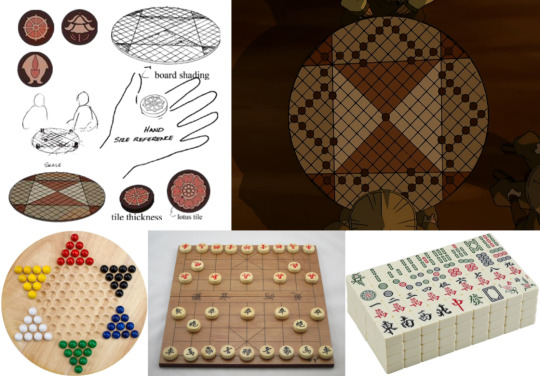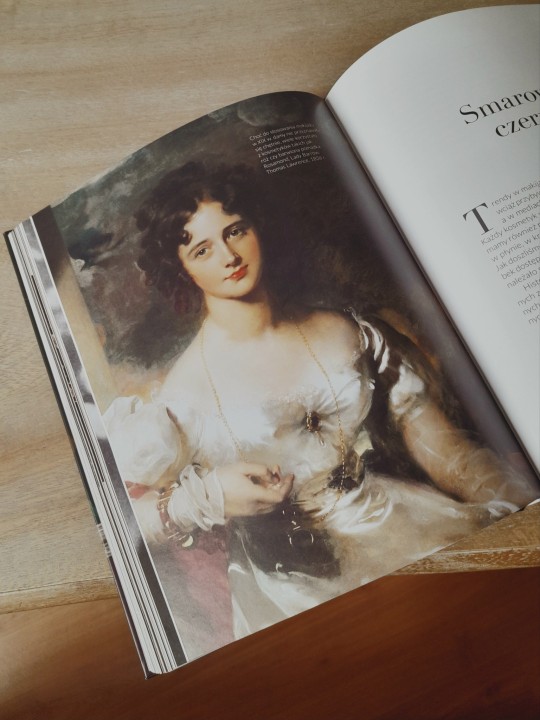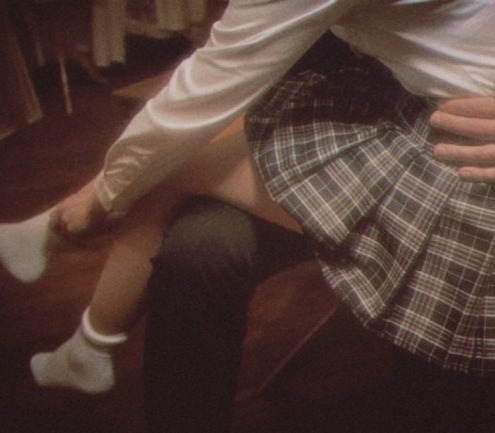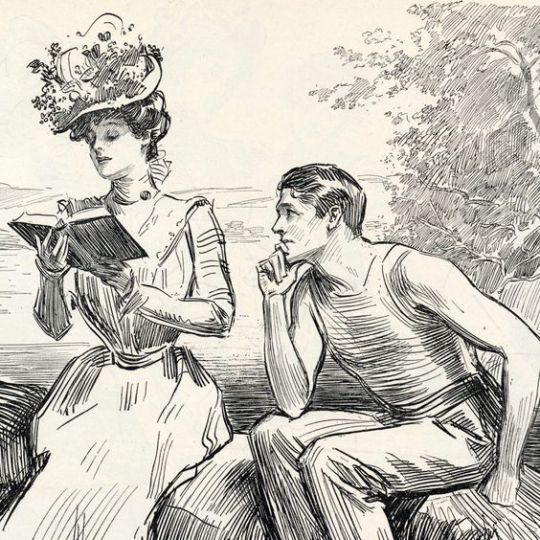#cultural practices
Text
Cultural Practices: Pai Sho - The Game
I'm honestly a little embarrassed it took me this long to get to this topic! As always, credit goes to @atla-lore-archive for saving all the neat ATLA tidbits and concept art from the old Nick website.

Pai Sho (牌數), meaning "several game pieces" in Chinese, takes inspiration from a few different table games:
Its most obvious influence is the German game Sternhalma, known in the English-speaking world as Chinese Checkers. Like Chinese Checkers, the game is played on a circular board.
The lines on the board and the circular tiles are reminiscent of Xiàngqí (象棋), known in the English-speaking world as Chinese Chess. The pieces often being positioned on the intersection of lines is also very similar to Chinese Chess.
The game's four player limit and visually creative tiles are reminiscent of Mahjong (麻将), China's most famous tile game. In particular, the iconic white lotus tile appears to draw heavily from the classic Mahjong one-dot tile.
Finally, the name Pai Sho was likely inspired by Pai Gow (牌九), meaning "nine game pieces" in Cantonese--- which is both a domino game and a style of poker.
Just like ATLA's animals, it seems that Pai Sho is a fusion of different real life sources. In the next posts, I'll be covering the symbolism and cultural significance behind each Pai Sho tile shown in ATLA.
Like what I’m doing? Tips always appreciated, never expected. ^_^
https://ko-fi.com/atlaculture
#atla#avatar#avatar the last airbender#cultural practices#water tribe#earth kingdom#fire nation#air nomads
524 notes
·
View notes
Text

Chad (1968) ©️ Bernard Louhaur
#chadian women and child#📸:bernard louhaur#blackisbeautiful#blackwomen#blackbeauty#blackwomanmagic#blackwomenaredivine#blackwomenarestunning#african culture#blackandbeautiful#cultural practices#cultural heritage#african heritage#african diaspora#africa#africanwomen#africanbeauty#african ancestry#africamatters#afrocentrism#darkskinmagic#melaninvibes#blackgirlmagic#black people#blackgirlaesthetic#black joy#blackpride#blackpower#blacktumblr
465 notes
·
View notes
Text
Personal Review (03/26/23)

Blood Debts by Terry J. Benton-Walker
Summary
In a version of New Orleans where magic is as common as cellphones, Clement and Cristina, twins, try to unravel an old conspiracy to protect their family. Clement has always admired generational magic, but his own attempts to practice it always seem to fall short. Compared to his sister, Cristina, who excels, he seems completely inept, but Cristina has stopped practicing magic due to a spell gone wrong that she's told no one about. When the twins discover a hex doll in their sick mother's bed, they are pulled into a mystery that spans generations and could change New Orleans for good.
TW: racism, homophobia (light), child abuse, blood, institutionalization, lynching
(Sorry I’ve been gone so long! You’ve no idea how busy I’ve been!)
Plot 1 2 3 4 5 6 7 8 9 10
This was a great combination between magical realism and mystery, bringing in healthy elements of each. The magic played a real and necessary role in the story, but it never overshadowed how important unraveling the mystery was. It was also a little unique in that the question wasn't who but how and why. Clement and Cristina know from the get-go who committed the murder, they just need to prove it to the public.
I also really like the magic of this story. It felt just more down-to-earth than the sweeping, dramatic spells that typically come with fantasy. There's a lot of detail about how certain spells work and how components contribute to that, and it feels like the author is familiar with the practice, or at least did a lot of research. The take on gods and their interactions with humans is also quite refreshing. The gods are involved in human life in a way I don't often seen in fantasy, with them appearing in bars and on people's doorsteps. Still, they don't lose the power and otherworldliness that would typically be associated with a deity.
One thing that I found difficult about this book was a general lack of urgency. While there are many great scenes with good tension, the moments were Clem and Cris are just researching or talking or anything, the momentum stalls. This is mostly because while this is a very important thing to the twins, there is ultimately no time limit. They aren't trying to get ready for an event or beat the clock on a spell or anything like that. As such, the tension, which is quite good in individual scenes, is lost in the in-between moments.
Characters 1 2 3 4 5 6 7 8 9 10
Cristina and Clement are twins and share most of the narration, but they're pretty distinct in terms of personality. They have different ideologies concerning a lot of things, such as magic and morality, which generates a lot of conflict. Cristina was my personal favorite, just because I found her guilt and flexible morality quite interesting, and her arc felt complete. Not that I didn't like Clem, I just prefer my protagonists willing to commit murder, though he seems on his way by the end of the book. The way this book deals with grief is quite good, and Clem bears the brunt of it.
My favorite side character was probably Valentina. Don't get me wrong, I despised her, but I found her to be a great character with a lot of insight into the other side of things. I'm really interested to see how she develops in the next book considering what she's going through at the moment. Jean-Louise, who gets one chapter from his perspective, is incredibly complex, but it doesn't seem like we'll be getting more of him, which sucks. The other perspective side character, Zachary, can rot in hell, I don't want to see anything about him.
While I appreciated how complicated things were in Cris and Clem's family, I feel like it isn't addressed enough. Their mother and aunts have been estranged for quite a while, and while this is only the first book, Mama and Aunt Ursula have a reconciliation that seems rushed. I also feel like the only aunt I really know is Ursula—the rest are barely there.
Writing Style 1 2 3 4 5 6 7 8 9 10
The writing itself didn't particularly stand out to me. There was nothing bad about it, but nothing took my breath away either. I think there's a good balance between the more archaic, flowery writing associated with magic and fantasy and the modern, casual speech of today. There are very few pop culture references, and they are kept vague enough that it won't date the material. I think the pacing was good; other than those stalls I mentioned earlier, the build is steady and feels like a natural progression.
My major gripe is probably the style of narration, in that it has little variation. While Cris and Clem are very distinct in terms of personality, their narration is very similar. I often found myself flipping back to the chapter title to check who was speaking or checking which twin was actually getting called by their name since it was in first person. My final issue is with the texting. There is no indication as to who is sending which text, and sometimes people were double- or triple-texting, and I basically had to make educated guesses as to who was speaking.
Meaning 1 2 3 4 5 6 7 8 9 10
This book isn't as focused on modern issues as other contemporary stories are, but it by no means ignores it. Cris and Clem are Black, which affects their day-to-day lives significantly, and the backdrop of the story is filled with 'Redeemers', those who advocate for regulating magic. Gen (generational) magic is specifically a Black practice, born from necessity during American slavery. White people have their own magic, light and shadow magic, but the desire of certain white characters to be involved in gen magic plays a huge role in the story, especially how gen magic is targeted more than light or shadow.
My one issue is that I can't really pinpoint how the author wants us to feel about the Redeemers. It is an obvious issue that their efforts are the result of a long-ago murder of a white woman (that ended in a lynching) and inordinately targets gen magic. However, direct comparisons are drawn between it and gun control, which makes me inclined to support at least some restrictions, especially considering how magic is utilized for truly horrible means in this book. The characters never outright say how they feel about the Redeemers, but it seems to be mostly negative, which I am hesitant to side with.
Overall 1 2 3 4 5 6 7 8 9 10
I think this is a good book. The plot is interesting with a unique take on magical realism, the main characters are complex, and it addresses some important issues with magic as a stand-in for all kinds of cultural practices. I have my issues, mostly with the lack of urgency, narration, and unclear message, but they are by no means dealbreakers. The cliffhanger is attention-grabbing, definitely enough to get a reader to want to read the next book, and I just love Cristina so much. This book comes out on April 4th, so be sure to give it a shot!
Thank you to NetGalley and the publisher for a digital advanced reader copy in exchange for a fair and honest review.
The Author
Terry J. Benton-Walker: American, also wrote Alex Wise vs the End of the World and The White Guy Dies First
The Reviewer
My name is Wonderose; I try to post a review every week, and I do themed recommendations every once in a while. I take suggestions! Check out my about me post for more!
#books#reviews#blood debts#terry j benton-walker#fantasy#ya#magical realism#black mc#black author#lgbt mc#lgbt author#twins#voodoo#cultural practices#new orleans
15 notes
·
View notes
Text
Dragon on fire
The fire of the dragon of Sar Kong was seen again last evening, making a reappearance on the streets around its lair at the Mun San Fook Tuck Chee temple. The temple introduced the fire dragon dance in the 1980s, importing a tradition from Tai Hang Village in Hong Kong that has its origins in 1880. Mun San Fook Tuck Chee’s dance of the fire dragon, which usually makes an appearance once every…

View On WordPress
#Cultural Practices#Dragon Dance#Festival#Fire Dragon#Fire Dragon Dance#Forgotten Places#Mun San Fook Tuck Chee#Mun San Fook Tuck Chee Temple#Old Places#Photographs#Photography#Religious Festivals#Religious Practices#Religious Traditions#Singapore#Taoist Practices#Taoist Temple#Traditions
2 notes
·
View notes
Text
Traditional Uses of Pine Resin in Indigenous Cultures

Pine resin has played a significant role in the cultural and practical traditions of indigenous communities around the world for centuries. Its versatile properties have made it invaluable in various aspects of daily life and cultural practices.
Medicinal Applications: In many indigenous cultures, pine resin has been used for its medicinal properties. It has been applied topically to treat wounds, burns, and skin infections due to its antiseptic and anti-inflammatory properties. Additionally, pine resin has been used in traditional remedies for respiratory ailments and as a natural adhesive for securing bandages.
Ceremonial Practices: Pine Resin holds spiritual significance in many indigenous cultures and is often used in ceremonial rituals and offerings. It may be burned as incense during ceremonies to purify the air and create a sacred atmosphere. The aromatic smoke of burning pine resin is believed to carry prayers and intentions to the spirits, fostering connection and harmony with the natural world.
Craftsmanship and Artistry: Pine resin has long been used as a natural adhesive in indigenous craftsmanship and artistry. It is used to bond materials together in the construction of tools, weapons, and traditional dwellings. Pine resin-based adhesives have also been used in the creation of art objects, such as sculptures, pottery, and textiles, adding strength and durability to the finished pieces.
Preservation and Waterproofing: Indigenous cultures have employed pine resin for its preservative and waterproofing properties. It is applied to wooden implements, baskets, and containers to protect them from moisture, decay, and insect damage. Pine resin coatings help extend the lifespan of these items, ensuring their longevity and usability for generations to come.
Food and Beverage Preservation: Pine resin has been used in indigenous food preservation techniques to seal containers and inhibit spoilage. It is applied to the seams of vessels such as clay pots and gourds to create a watertight seal, preventing the entry of air and microbes that can cause food to spoil. Pine resin coatings also impart a subtle flavor and aroma to stored foods and beverages.
Get More Insights On This Topic: Pine resin
#Pine Resin#Indigenous Cultures#Traditional Medicine#Natural Adhesive#Cultural Practices#Sustainability#Craftsmanship#Environmental Stewardship
0 notes
Text
I think it's really funny when a bunch of people will talk about a specific [thing] from [culture] that they don't belong to and defend it. Like "oh [thing] is something [culture] does it's part of their way of life!" And then someone from [culture] will show up and be like "yeah I know and I fucking hate it actually, stop defending it". Just goes to show.
1 note
·
View note
Text


Bluestockings. The school girl phenomenon
Moi je m'appelle Lo-lita,
Collégienne aux bas,
Bleus de méthylène
This fragment of the lyrics comes from the song by Alizée Moi… Lolita released in 2000 and probably many people from Europe, where it topped the charts, hummed it in its glory days. Apart from the references to Nabokov's novel, the remaining two lines can be translated as Schoolgirl in stockings, Methylene blue. So what is the deal with these blue socks and what does it have to do with young seductresses?
Queen of the Blues
Contrary to appearances, the blue stockings do not concern only the students themselves, but also their guest. We need to go back to the 1750s when the Blue Stocking Society was founded. It was a loose organization of privileged women interested in education who gathered to discuss literature, inviting educated men to participate. European fashion of the mid-18th century, in which black stockings were worn with formal wear and blue stockings were worn during the day or more casually, emphasizing the informal nature of club meetings. The most common such reference is to a man, Benjamin Stillingfleet, who reportedly did not wear formal black stockings and yet belonged to the Blue Stockings Society [1].


Thanks to the strong personality of another famous salon owner and writer, Elizabeth Montagu, the so-called Queen of the Blues, the term bluestocking soon came to refer to all literary women. Until the 20th century, there was much criticism of girls acquiring knowledge because, according to the prevailing stereotype, it eliminated them from being a good wife and mother. The opposite of bluestocking and other popular-culture image was the sweet girl graduate who used her education to find and impress her future husband [L. Peril, College Girls. Bluestockings, Sex Kittens, and Coeds, Then and Now, 2006 , pp. 28-31].
Collégienne look
Compared to the 18th century, today skirts have become much shorter, revealing the knees and with them the socks (but not particularly blue) . In the 20th century, along with clothing, the perception of female sexuality also changed. Back then, there was a double view of the image of a school girl: Bluestockings in class, and silk hose and silver slippers in the evening [E. Eldridge, Co-ediquette: Poise and Popularity for Every Girl, 1936, p. 136]. Although some believed that a student's appearance must correspond to her age: Moreover, the boy who invited Sally to the house party likes her as he remembered her at home and does not want a blase woman who looks thirty-five in her place [E. Post, Etiquette, 1942, p. 339].


Long-lasting erotic symbol
Over time in the 1950s, men's magazines discovered the cute and innocent college girl. And they began to show her as first in a school uniform, and later as a half-naked object of gazes. It wasn't until the late 1960s that they featured full nudity or even frontal views, and scantily clad female students seemed to be one of the delights of school life.
However, the 1950s are not the starting point for combining eroticism with young, studying girls. Almost from the very beginning, the student was surrounded by a rapidly commercialized aura of eroticism: At the turn of the twentieth century, the college girl was as much an object of public interest as Civil War battlefields or the natural wonders of Yosemite [L. Peril, College Girls..., p. 311].


Now I'm left to ask my favorite question when analyzing any cultural phenomenon, why does it work?
The school uniform, with blue or white stockings, is both a fetish and a symbol of childhood. A female student or even a college girl exudes innocence, but also youth. And as we know, youth itself (even more so when wearing a short skirt) can be an erotic incentive. And maybe that is why the sympathy for such an image is related to the pursuit of maintaining eternal youth, which is the best seller in the consumer world?
#cultural phenomenon#cultural practices#school girl outfit#alizee#Alizée moi lolita#sex kitten#bluestockings#bluestocking#lynn peril#coquette dollete#dollete aesthetic#college girl
1 note
·
View note
Text
Woman Caught Repeatedly Eating Stale Bread After Washing It at Night, Surprising Reason Unveiled
Woman Caught Repeatedly Eating Stale Bread After Washing It at Night, Surprising Reason Unveiled
Woman Caught Repeatedly Eating Stale Bread After Washing It at Night, Surprising Reason Unveiled
In a bizarre incident that has left many astonished, a woman was caught red-handed indulging in a peculiar habit of washing stale bread at night before consuming it. The revelation of her unusual…

View On WordPress
0 notes
Text
Every remake of a game should come with a copy of the game it is remaking that is compatible with modern hardware but otherwise untouched and I'm not even exaggerating this should be mandated by law. If you're going to attempt to recreate a piece of art you have to give people access to its original context otherwise it becomes the only context and makes the previous version simply a superceded product
#eldritch chatter#getting unreasonably upset thinking about the sh2 remake becoming peoples only touchstone for the series#and then having everything the original did and and all its jank (intentional and not) get lost#its the same as losing the original versions of star wars with the practical effects#it keeps people from actually engaging with the culture that the remake came from and understanding it and that makes me want to chew glass
13K notes
·
View notes
Text
Unlocking the Mysteries: What Happens After 72 Hours of Fasting?
Dive into the captivating realm of the body’s response after 72 hours of fasting. Uncover the intricate physiological and mental transformations, the benefits that extend beyond the fasting period, and valuable insights for a successful extended fast.
Embarking on the Fasting Odyssey: A Journey Within
Fasting, a practice steeped in history, has taken the modern world by storm with its potential…

View On WordPress
#Cultural Practices#Detoxification#diet#Eating Habits#Fasting#Fasting Benefits#food#health#holistic health#Meal Planning#Metabolism#Mindful Eating#Nutrition#Religious Practices#Self-Discipline#Spiritual Practices#Weight management#Wellness
0 notes
Text

The Fulani, also known as the Fula or Fulbe, are a prominent ethnic group in Africa. They are scattered across Western and Central Africa, with significant populations in countries like Nigeria, Senegal, Mali, Guinea, Niger, Mauritania, Cameroon, Sudan, Chad, Sierra Leone, Burkina Faso, Benin, Guinea-Bissau, Gambia, Ghana, South Sudan, and Côte d’Ivoire.
#aissata ba#@tiitaba#📸:@bashproshoot#blackisbeautiful#blackwomen#blackbeauty#blackwomanmagic#blackwomenaredivine#blackwomenarestunning#african culture#blackandbeautiful#cultural practices#cultural heritage#cultural photoshoot#african heritage#african diaspora#africa#africanwomen#africanbeauty#african ancestry#africamatters#afrocentrism#darkskinmagic#blackgirlmagic#black people#blackgirlaesthetic#black joy#blackpride#blackpower#blacktumblr
330 notes
·
View notes
Text
How can we talk about herbal medicine: The “West is Right” Model of Herbal Medicine
Explore the rich landscape of herbal medicine and its efficacy, drawing from both traditional wisdom and modern research. Discover the intricate balance between cultural practices, scientific evidence, and safety considerations in herbal remedies. From th
How can we talk about herbal medicine: The “West is Right” Model of Herbal Medicine
There is a wide range of herbal remedies that have been used for centuries and many have shown varying degrees of effectiveness for certain conditions. However, the documented herbal medicine, traditional medicine, efficacy of herbal remedies, West Is Right model, scientific evidence, placebo effect,…

View On WordPress
#Acupuncture#anecdotal evidence#annabackacupuncture#balance in regulation#biological complexity#brentwood#collaborative healthcare#cultural practices#efficacy of herbal remedies#healthcare decisions#healthcare empowerment#Herbal Formulas#herbal interactions#Herbal interactions with medications#herbal medicine#Herbal medicine benefits#Herbal medicine effectiveness#herbal medicine regulation#Herbal medicine research#herbal medicine safety#herbal remedies#herbal research#herbal supplement industry#holistic healthcare#Integrating herbal medicine#malibu#modern research#pacific palisades#palos verdes#personalized treatments
0 notes
Text
st patrick’s day easily the funniest american holiday. nothing makes me more patriotic than watching everyone collectively pretend to be from somewhere else as an excuse to get trashed in the street and wear lots of green. ideal
4K notes
·
View notes
Text
Fundal Pressure in Labor: Balancing Practice and Potential Risks
During labor, healthcare providers may employ various techniques to assist with the delivery process. One such technique is fundal pressure, which involves applying pressure on the upper abdomen to aid in the descent and expulsion of the baby. While fundal pressure has been used for decades, its effectiveness and potential risks have been the subject of debate. In this blog post, we will explore the main points from several studies and shed light on the practice of fundal pressure, its purpose, and the associated consequences.
Understanding the Practice and Prevalence:
A systematic review and meta-analysis conducted by Farrington et al. (2021) examined the prevalence of uterine fundal pressure during the second stage of labor. The study revealed that fundal pressure was utilized in a considerable number of cases, with variations observed across different regions and healthcare facilities. For instance, in some low- and middle-income countries, the use of fundal pressure was more prevalent compared to high-income countries, highlighting the influence of local protocols and traditions.
The Potential Effects and Consequences:
To assess the impact of fundal pressure, Buhimschi et al. (2002) conducted a study on intrauterine pressure during the second stage of labor. The research demonstrated that fundal pressure increased the intrauterine pressure significantly. While this might aid in fetal descent, it also raises concerns about potential adverse effects on maternal and fetal well-being. Excessive uterine pressure can lead to potential complications, including maternal perineal trauma, prolonged second stage of labor, and fetal distress, as highlighted by Pinar and Karaçam (2018).
The Call for Caution and Critical Appraisal:
Papadakis (2019) critically appraised the role of fundal pressure in labor, emphasizing the principle of "First, do no harm." The study highlighted the lack of scientific evidence supporting the routine use of fundal pressure, especially in cases where it is not medically indicated. Papadakis cautioned against the potential risks associated with fundal pressure and stressed the importance of individualized care and shared decision-making between healthcare providers and birthing individuals.
The Importance of Informed Decision-Making:
Fundal pressure should be employed cautiously and with a thorough understanding of the potential risks and benefits. Healthcare providers must engage in shared decision-making with birthing individuals, considering their unique circumstances and preferences. Informed consent and adherence to evidence-based practices are crucial in ensuring the well-being of both mother and baby during childbirth.
--
The practice of fundal pressure during labor continues to be a subject of debate in the medical community. While it is employed in certain circumstances to aid in the delivery process, there are potential risks and adverse consequences associated with its use. Healthcare providers must carefully consider the benefits and harms, taking into account the specific context of each laboring individual.
For example, in low-resource settings where alternative interventions may be limited, fundal pressure could be utilized judiciously to assist with delivery. However, in other cases, the routine use of fundal pressure without medical indication may pose unnecessary risks. Individualized care, shared decision-making, and critical appraisal of the available evidence are essential in ensuring the safety and well-being of birthing individuals and their infants.
As research continues to advance, it is crucial to critically evaluate the practice of fundal pressure and prioritize the principles of beneficence and non-maleficence in childbirth. By promoting informed decision-making and evidence-based practices, healthcare providers can navigate the complexities of fundal pressure and strive to optimize outcomes for both mothers and babies.
References!
Buhimschi, Catalin S., et al. "The effect of fundal pressure manoeuvre on intrauterine pressure in the second stage of labour." BJOG: an international journal of obstetrics and gynaecology 109.5 (2002): 520-526.
Farrington, Elise, et al. "The prevalence of uterine fundal pressure during the second stage of labour for women giving birth in health facilities: a systematic review and meta-analysis." Reproductive Health 18.1 (2021): 1-17.
Mahendru, Rajiv, Savita Malik, and Tina Anand. "Age old practice of Uterine Fundal Pressure in Labor-more risky than beneficial." Biomedical Research 21.3 (2010): 295-296.
Papadakis, Konstantinos. "Critical appraisal of the role of applying uterine fundal pressure in labour: First, do no harm." Hypertension Research in Pregnancy 7.1 (2019): 22-26.
Pinar, Semra, and Zekiye Karaçam. "Applying fundal pressure in the second stage of labour and its impact on mother and infant health." Health care for women international 39.1 (2018): 110-125.
#medical anthropology#anthropology#global health#medicine#fundal pressure#maternal health#neonatal health#obgyn#cultural practices#traditional practices#do no harm#pregnancy#childbirth#birth
0 notes
Text
Exploring Traditional African Wedding Practices: Evaluating Pagan Elements from a Christian Perspective
In a traditional African wedding, there are various cultural practices and rituals that may vary depending on the specific ethnic group and region. These practices are often deeply rooted in African traditions and may reflect elements of paganism or indigenous religious beliefs. From a Christian perspective, the interpretation and evaluation of these practices can vary among individuals and…

View On WordPress
#africa#Ancestral veneration#Brendon Naicker#Bristol church#Christian faith#Christian perspective#Christian theology#Churches Unite#Compatibility#Conflict#Cultural practices#Cultural preservation#Dialogue#Discernment#Guidance#Integration#joburg church#London City Church#Pagan elements#Rituals#Theology#Theology School#Traditional African weddings
0 notes
Text
*completely serious tumblr user voice* oppression was actually invented by Big West sometime in the 1800s. no one was oppressed anywhere before that.
#re: that classical faggotry post#also the way ppl talk abt colonized cultures' practices....#i swear u dont have 2 pretend everybody loved gays n trans ppl as a way to say they didnt ''deserve'' colonialism#mine*
1K notes
·
View notes